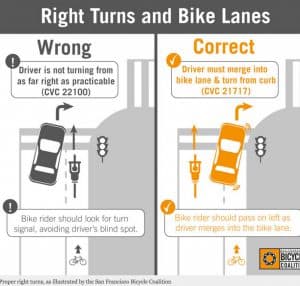
With California’s Three Feet for Safety law now in effect, we thought we’d present an overview of California laws designed to help drivers and cyclists share the road safely
Motorists & Cyclists
- Rights and Responsibilities: Cyclists have the same rights and responsibilities as motorists. Both have the right to use the roadway; both are responsible for signaling turns and stops, as well as stopping at all red lights and stop signs. (CVC 21200, CVC 22107, CVC 22111)
- Yielding to pedestrians: Drivers and cyclists must yield to pedestrians, whether they are crossing the roadway within a marked crosswalk or within an unmarked crosswalk at an intersection. Crosswalks must be left free and clear for pedestrians. (CVC 21954 (b), CVC 21950, CVC 21455)
- Blocking a Bike Lane: Neither motorists nor cyclists may stop in a bike lane or on a bike path. (CVC 21211, CVC 22512)
- Turning Out of Slow Moving Vehicles: On a two-lane highway where passing is unsafe because of traffic in the opposite direction or other conditions, a slow-moving vehicle (including bicycles and passenger vehicles) behind which five or more vehicles are formed in line, shall turn off the roadway at the nearest place designated as a turnout or wherever sufficient area for a safe turnout exists, in order to permit the vehicles following it to proceed. (CVC 21656)
Motorists
- Passing Cyclists: When passing a cyclist, motorists are required to allow at least three feet between their vehicle and the cyclist. If doing so would cause a hazard, they must slow down and pass the cyclist only when it is safe to do so. (CVC 21760)
 Turning Across a Bike Lane: When making a right turn that involves crossing a bike lane, the driver must merge into the bike lane and turn from the curb. State law requires that all right-hand turns be made from “as far right as practicable.” (CVC 21717, CVC 22100)
Turning Across a Bike Lane: When making a right turn that involves crossing a bike lane, the driver must merge into the bike lane and turn from the curb. State law requires that all right-hand turns be made from “as far right as practicable.” (CVC 21717, CVC 22100)
- Opening and Closing Doors: Before opening doors, drivers must look for oncoming traffic and may not open the door unless it is reasonably safe to do so and can be done without interfering with the movement of traffic. The door must not be left open longer than necessary to load or unload passengers. (CVC 22517)
Cyclists
- Travel Lanes: Cyclists moving at less than the speed of traffic must ride as close to the right side of the road as is safe & practicable. Cyclists have the right to take the lane when passing, preparing for a left turn, if the lane is too narrow to share, or if they are approaching a place where a right turn is authorized. (CVC 21202)
- Bicycle Lanes: On a roadway with a bike lane, bicyclists traveling slower than traffic must use the bike lane, with the same exceptions as noted above. (CVC 21208)
- Moving Left to Avoid Hazards & Pass: Cyclists are allowed to move left to avoid hazards like fixed or moving objects, hazardous surface conditions, animals, glass, etc. This includes moving left when passing a vehicle (esp. a turning vehicle turning right) or another bicycle traveling in the same direction. (CVC 21202 (a))
- Riding on Sidewalks: Individual cities and counties control whether bicyclists may ride on sidewalks. Check local regulations. (CVC 21206)
Bicycle Operation & Required Equipment
- Helmets: Cyclists and bicycle passengers under age 18 must wear a helmet when riding on a bicycle. (CVC 21212)
- Head phones: Bicyclists may not wear earplugs in both ears or a headset covering both ears. (CVC 27400)
- Use Lights at Night: A white headlight and reflectors are required by law if riding when it’s dark. (CVC 21201)
- Ride with a Brake: A bike must be equipped with a brake that enables the rider “to make one braked wheel skid on dry, level, clean pavement.” (CVC 21201)
